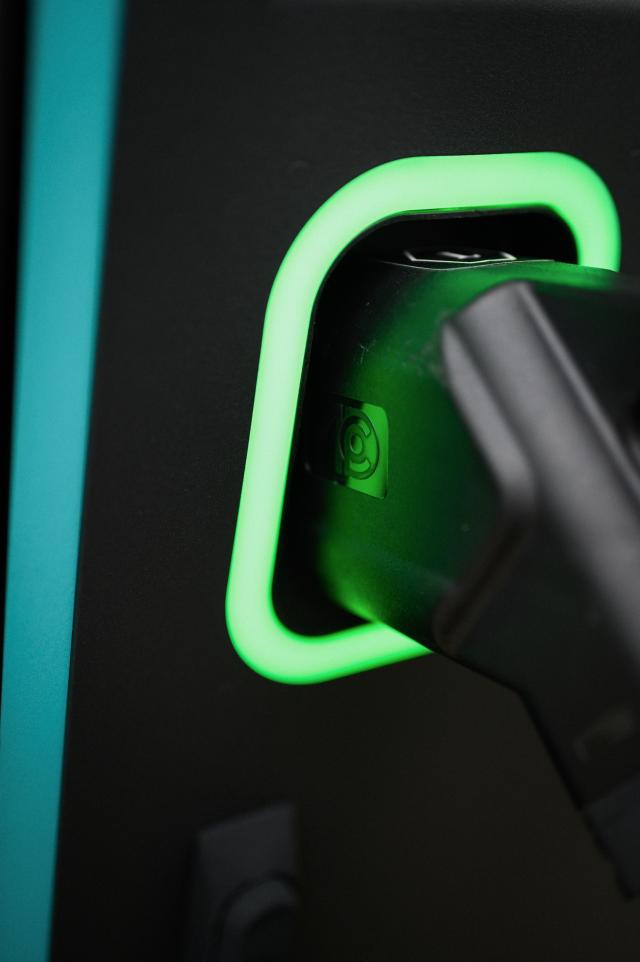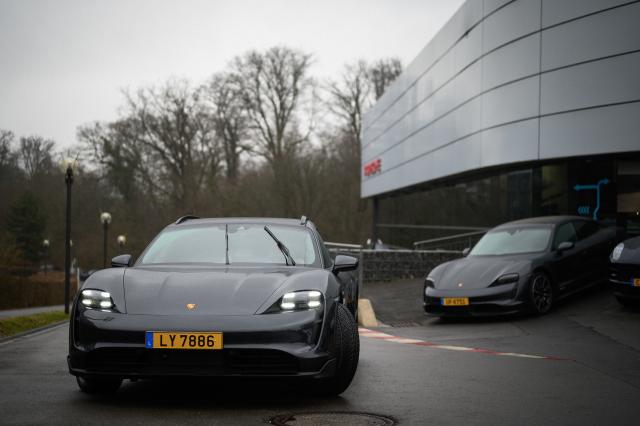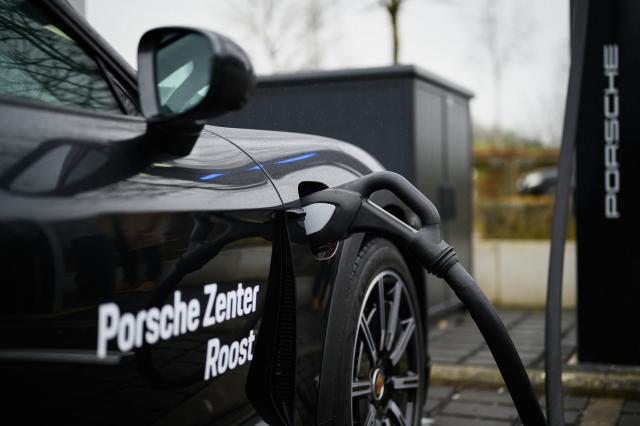E-volution - The cycle of energy and mobility
Sponsored content Switch to German for original article
Listen to this article
We dive into the world of electromobility in this series with SWIO and show the way people, whether convinced users or pioneers, think. We also explain the exciting developments in this field and show how visions of the future are gradually becoming reality.
"By 2030, the mobility world will have experienced the greatest transformation since the transition from the horse to the car at the beginning of the 20th century." This confident statement by Volkswagen AG Chairman Herbert Diess makes it quite clear that electromobility has a prosperous future. All over the world, sales of electric vehicles are already increasing exponentially and from 2035 onwards, only climate-neutral cars are to be registered in the EU. A rapid increase can also be observed in Luxembourg. While in 2020, 2,195 of a total of 426,228 registered vehicles had an electric drive, in 2021 there were already 4,444 e-cars. That is more than double. And the trend is pointing steadily upwards. "Sales in the global smartphone market, including app stores, were $500 billion last year. The automotive market is expected to grow to a volume of 5 trillion euros by 2030 – that's ten times bigger!", claims Herbert Diess.
At first glance, this figure seems almost astronomical and one can legitimately ask how this sum actually comes about. Part of it, of course, comes from the sale of cars. And the rest is made up of a network of different infrastructures and actors that make electric mobility possible in the first place – or in other words: the cycle of energy and mobility. And that's exactly what we're going to get to the bottom of.
The best place to start at is the charging station itself. Anyone with a public parking space has the possibility to install and operate one or more charging stations, and is completely free to decide on the type of construction and on the brand used. Of course, if a charging station is located on a motorway, it makes most sense to invest in DC fast chargers in order to offer long-distance travellers an optimal result. Companies that focus on charging stations at restaurants or shopping centres, on the other hand, "only" need the slower and cheaper AC chargers. Once operators have purchased the appropriate hardware, they can install it and connect the charging stations to the local power grid. They then usually sign a contract with an energy provider to supply the charging stations with electricity and then proceed to sell this electricity to the drivers.


In order for these charging stations to be used by as many users as possible, they first need to be connected to the local, regional or even European network. And this is where the Charge Point Operators (CPO) and the Mobility Service Providers (MSP) come into play. They are two crucial and interdependent building blocks of a charging network that jointly install and manage the charging stations for electric vehicles.
A CPO is a company that operates a network of charging stations. It manages the back-end technology and ensures that the charging network for electric vehicles is operational, accessible and stable around the clock. CPOs either own and operate their own charging stations or manage them for third parties.
So while a CPO manages and sets up the charging infrastructure, an MSP offers this charging infrastructure to the customers, helping the charging station owner or the CPO to earn money with their charging stations. In simpler terms, this means that the MSP issues charging cards with which end users can charge their vehicle at all stations of the respective network. In addition, the MSP also takes care of the payment options and billing. An MSP can integrate several CPOs into its network and thus provide its end users with access to an even larger network of charging stations. Through a specially developed app, the MSP offers its users an easy way to locate the different charging stations in the network across the country and across Europe.
"The electric car will become cheaper and cheaper over time thanks to economies of scale and advances in battery technology."
Herbert Diess, Chairman of Volkswagen AG
Each operator of one or more charging stations can make their charging network available to many different MSPs. To find and connect with compatible MSPs, CPOs have the option to open their network to roaming companies. "It actually works just like Tinder", says Marvin Rassel, coordinator at SWIO in Luxembourg, with a smile on his face. So there will always be a match.
Just as you can continue to use your phone while travelling abroad by connecting via local networks, e-car drivers can charge their vehicles via other e-mobility charging networks abroad. For the MSPs, this roaming also means an expansion of the potential user base, as they open their network to e-drivers who are actually registered with other charging networks. This simplification and harmonisation of charging networks can ensure fast and easy e-mobility growth. As the market for charging stations continues to grow, the boundaries between CPOs and MSPs are becoming increasingly blurred and the two types of companies are becoming harder to distinguish. In many cases, the CPO is also the MSP of a charging station.
In Luxembourg, for example, the company SWIO provides its customers with a complete charging management system for electric and plug-in hybrid vehicles, regardless of whether the car is used for private or business purposes. Thanks to the SWIO app and the SWIO charging card, you can not only charge from the comfort of your own home, but you also have the option of using over 200,000 public charging stations throughout Europe. When you buy an electric car, you receive your very own personal charging card as well as access to a specially developed app, and you receive all the information about the different subscription alternatives.
How is the price set?
-
As far as prices are concerned, charging station operators can set basic prices for the use of their charging infrastructure. These are usually made up of the following elements:
- An entry fee: the price an e-car driver pays to use the charging station.
- a volume-based charge: the price per unit of electricity consumed
- a time-based fee: this is usually charged in cents/minute
- A penalty fee: e.g. if a charging station is blocked after the vehicle is already fully charged.

Marvin Rassel

Each charging station owner can set their own tariff, e.g. based on their electricity contract. Through the contracts made with the owners, the CPOs as well as the MSPs and the roaming companies earn their share by adding a certain percentage to this fixed price. The sum of this then determines the price that the end user has to pay at the charging station. Herbert Diess, Chairman of Volkswagen AG, is certain of one thing in any case: "The electric car will become cheaper and cheaper over time thanks to economies of scale and advances in battery technology. The price of mobility will fall below today's level."
However, if you look at the current energy prices, you dare to doubt this statement. "On the spot market, the price of electricity has increased five to seven fold in some cases, " explains Dr Gaston Trauffler, Head of Industrial Policy at Fedil. And this will also affect the end users in the medium or long term, even if not at the same level. Now it is important to counteract this drastic price increase. "If you ask me, there are two ways to bring the price down again: on the one hand, the massive expansion of renewable energies and, on the other hand, a reform of the electricity market, " explains Dr Trauffler. "The good news is that today there are much lower minimum taxes on electricity than on petrol. That is a good thing. In order to promote electrification in mobility but also in industry, we must now manage to lower the price of electricity on the spot markets again."
"Ideally, the whole of Europe would be connected by a huge copper plate."
Dr Gaston Trauffler, Head of Industrial Policy at Fedil
It would be theoretically conceivable, thanks to regional power purchase agreements, to reserve some of the green electricity that is produced for the charging stations and then sell it to the charging station operators at a cost price plus grid costs. In this way, it would be possible to offer cheaper electricity for electromobility. "In this way, electromobility could be promoted even while market prices are high. But this approach is actually not very desirable." It would be better if the price could be lowered again in general, Trauffler continues. And that could ultimately only succeed if electricity production in Europe no longer depended on the generation of electricity from coal or gas, but could be covered by sufficient renewable energy sources at all times.
Today, Luxembourg is part of the German grid and gets more than 80 percent of its electricity from Germany. Within a grid there are fluctuations, because electricity demand rarely corresponds 100% to electricity supply. In order to keep the grid stable despite these fluctuations, the grid operators need capacities available at short notice, the so-called control energy, with which their control area is kept in balance. Not only controllable renewable energy sources such as hydroelectric power plants but also coal or gas-fired power plants are suitable for the provision of balancing energy – emergency generators or, electricity storage and converters as well as companies with controllable loads can also contribute to balancing energy. And Germany regulates this necessary distribution of loads in the grid for Luxembourg, among others. Unfortunately, there are insufficient connections between all European countries and control areas. "Ideally, the whole of Europe would be connected by a huge copper plate. That way you could, for example, fire up a hydroelectric plant in Sweden when there is a power shortage in Portugal, " explains Dr Gaston Trauffler.
If this worked, you could distribute renewable energy much more efficiently to where it is actually needed and thus make full use of it. For example, it would be possible to generate solar energy in sunnier countries, as well as wind energy in windier areas of Europe and then use it throughout Europe.

Dr Gaston Trauffler

Terji Nielsen
And it is precisely this kind of progressive idea that they are trying to implement in the Faroe Islands. Located in the North Atlantic, this group of islands is an interesting and unique microcosm, both in terms of electricity management and the promotion of sustainable energy.
Terji Nielsen is Head of R&D Department at the electricity company SEV in the Faroe Islands, where there is a strong commitment to the promotion and development of sustainable energy. He has been working at SEV for 23 years and has led the R&D Department there for about five years. The main task of his team is to look very specifically at different future technologies and to find out how to achieve the ambitious goal of making electricity generation carbon neutral by 2030.
"As an island, we have to maintain all electricity supply independently and ensure stability and quality of supply at all times", Terji explains. In 1921, the first hydroelectric power plant was built in the Faroe Islands, which was the predominant resource until the early 1970s. Then demand began to increase enormously and a whole series of diesel or fuel oil power plants were installed. For a long time, they used about 60 percent fossil fuels and 40 percent hydropower. But 8 years ago, the Faroe Islands announced their vision for 2030 and started looking for more alternatives. Hydropower alone was and is not the only solution, as the construction of reservoirs often requires kilometre-long tunnels to be bored into the mountains in order to tap rivers and lakes, which then dry up.
"If we can have the e-vehicles participate in the system stability, maybe there is the possibility of feeding energy back into the system."
Terji Nielsen, Head of R&D at the electricity company SEV
"However, we also have a lot of wind. In various places there are average wind speeds of more than 10 metres per second. And in the summer months we use some solar energy. We are also currently working with companies on research projects to find out whether tidal energy could be another alternative. We are looking at a special technology from a Swedish company called Minesto, which works by flying a kite out to sea. We now need to see if it can withstand the harsh conditions here in the Faroe Islands", Terji explains. Just two months ago, they received permission to build a huge pumped storage system. This will allow them to use surplus renewable energy to pump water into a reservoir, which in turn will be used to generate new energy when there is a shortage.
Similar to many other countries, the Faroe Islands are currently experiencing an exponential increase in electric vehicles. Over 800 are already on the road there. However, if they are all to be powered by renewable energy, a very specific problem must be solved. What happens when there is no wind? What do they do when the sun is not shining? How do they guarantee a permanent flow of electricity? Shortly before the start of the pandemic, a London-based company had contacted SEV, claiming to have found a solution for bidirectional charging. In this area, the Faroe Islands could serve as guinea pigs, as in this microcosm the results and effects of a test run can be perceived almost immediately. "So if we can have the e-vehicles participate in the system stability, maybe there is the possibility of feeding energy back into the system. And if we have problems with a wind farm or a hydroelectric plant, we can draw energy from the batteries [of the e-cars] for 10 to 15 minutes while we ramp up other plants."
A vehicle-to-grid project in Denmark showed that the battery capacity of the electric cars involved did not suffer from bidirectional charging. Quite the opposite: the batteries were even said to be in better shape afterwards than before. Hopefully, these progressive approaches will inspire many more countries in the years to come, so that in the very near future the whole world will be able to function with green electricity and sustainable energy.
Why use a wallbox at home?
-
A wall charging station can regulate the flow of electricity, which is gentler on the home's electrical installation. SWIO is a 360° charging management solution for electric and plug-in hybrid vehicles. With its charging capacity of 11 kW, the SWIO wallbox enables charging five times faster than at a household socket and is suitable for all e-vehicles thanks to its universal charging plug. The SWIO app and RFID card guarantee secure access to the wallbox. With the smartphone, the charging processes can be configured and controlled, and even adapted to the energy consumption of the entire house. For more information, visit www.swio.lu.
-
An appointment is made with the SWIO installation partner for a house check. The architectural conditions are checked and the application for the grid operator is filled out and sent in. In Luxembourg, all e-car charging systems with a capacity of more than 7 kW for three-phase connections (4.6 kW for single-phase connections) must be applied for and subsequently approved by the grid operator.
After the application has been approved, the SWIO installation partner arranges a second appointment to install and commission the SWIO wallbox. At a further appointment, the grid operator checks whether the wallbox has been connected in accordance with the applicable technical guidelines.
Each e-car charging system is connected to the SMARTY electricity meter with a control cable. If the grid is overloaded, the grid operator can switch the wallbox to a reduced load shedding mode. This means that the wallbox charges at reduced power for the required time. Afterwards, it automatically returns to normal charging mode, i.e. it charges again at maximum power. With the SWIO wallbox, you can therefore always charge, unlike other charging installations that cannot adjust their charging power.
-
The state subsidises intelligent charging points such as the SWIO wallbox with 50 percent of the acquisition costs (excl. VAT) and up to a maximum amount of 1,200 euros.












